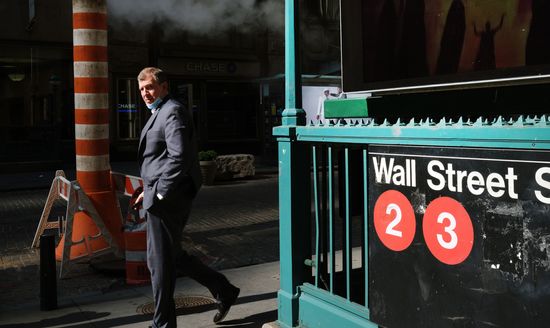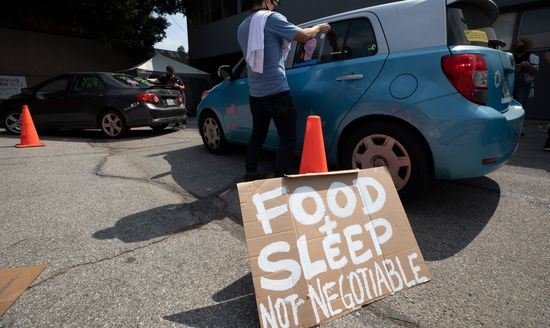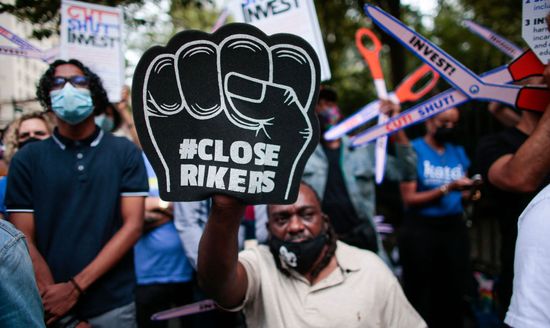| Ben: The inflation news we got yesterday isn’t ideal. The price of seemingly everything in America, from rent to furniture to cars, is still rising, with an overall 5.4 increase from a year ago — the highest yearly spike since 2008. This has dashed consumers’ (and the Biden administration’s) hopes that such price increases, which are directly connected to COVID economic aftershocks, would fade quickly. First of all, what is your understanding of why this is all still so severe? Does it remain primarily a supply-chain problem, where too many people want goods that can’t be produced with the same speed and efficiency they could pre-pandemic? |
| Eric: There are a few different things going on. First, as you say, the pandemic has wreaked a lot of supply-side havoc. At the onset of the COVID recession, semiconductor manufacturers slowed production, failing to anticipate that a world of lockdowns would actually be one of higher demand for products with microchips, economic crisis notwithstanding. At the same time, the electric-vehicle revolution and the “internet of things” were already increasing demand for chips at a rapid rate. The industry is still having a difficult time ramping up production to meet demand, and that’s putting upward pressure on the price of a large category of stuff. A shortage of semiconductors has also translated into a shortage of new cars, which has sent used car prices surging. |
| There is also a lot of dislocation in the labor market. Many millions of workers lost their jobs over the past year. Thanks to enhanced UI benefits, many had the chance to live relatively comfortably for a bit and consider other potential career choices. Now, some employers are finding that they have trouble staffing at the wage rates they’d grown accustomed to. This appears to be especially true of the trucking industry, which is suffering an apparent shortage, as workers resist entering that quite demanding and risky profession for pre-pandemic compensation levels. |
| Perhaps the most significant supply-side issue, though, is energy, since it’s a key input in virtually every good. Gasoline prices were 42.1 percent higher last month than they’d been in September 2020. Energy prices are famously volatile. But there’s reason to think we might be entering a period of structurally elevated energy prices, due in part to global decarbonization efforts. From an ecological perspective, we’re still investing too much in new fossil-fuel production. But fear of stranded assets is impeding new investment in carbon energy. According to the IEA, projected spending on oil and gas will be insufficient to keep pace with current consumption trends. Which would not be a problem if global investment in renewables were rising to fill that gap, but it isn’t. (We’ll probably get to this in a minute, but there is a deep irony in the possibility that high inflation will lead governments to spend less on green energy, thereby exacerbating long-term inflation.) |
| All of this said: Supply is only one side of the equation. As Matt Yglesias noted this week, demand for goods in the U.S. is up massively from 2019 levels. The cause there is twofold: (1) During the pandemic, Americans shifted their spending away from services and toward finished goods. Although major pandemic restrictions have been lifted in most of the country, consumers are still devoting an unusually high share of their spending to goods. This could be a temporary source of pressure; last month’s data may reflect the Delta surge. Or consumer habits might have durably changed (although, at some point, the high cost of goods might nudge consumers to spend more on live entertainment, restaurants, yoga instructors, etc). (2) U.S. households built up a lot of savings last year, as they cut back on dining out, vacations, and myriad other discretionary expenditures in the pandemic context. That plus the various checks and fiscal supports the government sent out left Americans with far more savings after COVID than before. |
| For these reasons, even if COVID hadn’t discombobulated global shipping and domestic trucking, the surge in goods demand would still be creating bottlenecks at ports and warehouses by itself. |
| Ben: Economists and policy-makers now seem resigned to the fact that these elevated prices might be the norm for considerably longer than they expected. This increases pressure on the Biden administration, which sees inflation as a major political problem for them, as well as on the Federal Reserve. But can either entity do much to change this dynamic, and what are the risks involved in intervening too much or in the wrong way? |
| Eric: The basic problem is that the federal government currently has one very blunt and potentially counterproductive tool for fighting inflation, which is raising benchmark interest rates. As a treatment for inflation, interest-rate hikes are a bit like a medication that definitely has awful side effects and might actually make the illness it’s treating worse, depending on the nature of your condition. |
| To get more specific: If the Fed raises benchmark interest rates, it will put upward pressure on the price of credit through the economy. That should discourage new spending and investment on the margin, and thus mildly reduce demand and, theoretically, prices. On the other hand, in a context where supply-side bottlenecks are major contributors to the price problem, raising rates could actually make things worse. We need more car production and home construction, not less, if we want to reduce prices in the vehicle and housing markets. Yet if you make it more expensive for carmakers and construction firms to borrow, you are going to reduce supply in those sectors. At the same time, given Americans’ volume of pandemic savings, it’s not clear how much raising interest rates would even cool demand — unless you raised them high enough to trigger a recession.
Ideally, the government would respond to the current situation by identifying major, readily resolvable bottlenecks. The lowest hanging fruit — in practical terms — would be to loosen zoning restrictions that have created a massive shortage in housing. Unlike some other bottlenecks, this wouldn’t require magically securing more of a scarce material or rapidly onshoring a major industry. Simply making it legal for the private sector to sell more housing to people would go a long way toward containing prices (even if it would be insufficient for achieving housing justice). |
| In theory, the Fed could also use its bond-buying programs to channel credit toward specific sectors where more supply is needed. As J.W. Mason and Lauren Melodia of the Roosevelt Institute note, the Fed did a version of this after 2008, when it purchased mortgage-backed securities to sustain mortgage lending. Using that precedent, the Fed could arguably buy bonds financing green-energy projects, so as to bring down energy costs in the medium term. |
| Finally, the government could simply impose price controls on certain essential goods. Ironically, though this is arguably the most socialistic alternative to rate increases, it is also the most politically viable in D.C. today: If Joe Biden and the vast majority of congressional Democrats get their way, Medicare will “negotiate” drug prices next year. In reality, “negotiation” is a bit of a euphemism. The policy would empower the government to use its purchasing power to effectively force down drug prices. |
| There isn’t much appetite for using this tool in other sectors, though. And it would be hard for the federal government to change zoning policy nationwide, even if it wished to. The Fed, meanwhile, would likely see green bond-buying as outside its mandate.
So the best option for policymakers is to try to increase supply in whatever marginal ways they can (such as the recent effort to keep the port of L.A. open 24 hours), while otherwise letting markets work. As prices go up, demand should self-correct to a degree. Persistently higher prices would be a real burden to Americans. But so long as there is no accelerating, economy-wide increase in prices — and thus no threat of a self-reinforcing cycle of inflation, powered by higher inflation expectations — elevated prices will be preferable to interest-rate hikes large enough to force them down. The big risks are: (1) that policymakers will feel pressure to “do something” and pull the interest rate level because it is something, even if there’s little basis for thinking it will work, and/or (2) that congressional Democrats will shrink investments in green energy because of inflation, even though massive investment in renewables is necessary to avert persistently high energy prices in the years to come. |
| Ben: There still seems to be an assumption that this problem will stabilize in the medium term, even if it takes longer than originally anticipated. But do you see a possibility that it could actually worsen — or that forecasts calling for continued economic growth in the coming months might be as flawed as the ones anticipating a cessation of price increases — meaning that we could be facing a 1970s-style “stagflation” scenario? |
| Eric: I think there’s a good chance that, from the perspective of the typical American, things will worsen in the near term. Economists pay a lot of attention to “core CPI” — the consumer price index with food and energy stripped out. The rationale for this is that energy (and to a lesser degree, food) prices are unusually volatile. So if you want to get a sense of the general price trend, it’s best to bracket those two.
For the typical consumer, though, energy prices are probably the most salient item in the whole index. Americans don’t necessarily know the prevailing price of an airline ticket or used car at any point in time. But they typically know damn well what gas costs. As winter descends, and demand for energy for home heating surges, we’re likely to see major price increases and public discontent. |
| More broadly, I do think we could see a sustained period of tepid growth amid elevated prices. There are a lot of supply-side problems that will take time to resolve. And some have yet to make themselves fully felt. Energy shortages in China have throttled production for a wide range of exports, and that could translate to further price increases for American shoppers. But I would be surprised if anything analogous to the 1970s is in the offing. True, a global energy supply shock was critical to inflation both then and now. But two other forces powered 1970s inflation: (1) Collective bargaining agreements that included cost-of-living-adjustments, such that wages for a large minority of workers automatically increased with prices — which in turn led their employers to hike prices further — in a cycle that was especially vicious for workers who were not covered by such agreements. Today, almost no workers enjoy the benefits of such contracts. And organized labor is weak more generally. So it’ll be much harder to get a “wage-price spiral” going. (2) The baby-boomer generation was entering its prime purchasing years. This was an exceptionally large birth cohort, and as it started forming households en masse, demand for consumer durables increased. Today, we have a slightly similar thing going on, where the mass entrance of millennials into the homebuying market is pushing up prices. But our generation is much smaller than the boomer one. America is a much older country today than it was in the 1970s. And old people buy a lot less stuff than young people, all else equal, because they already own a lot of stuff. So today, demographics are actually deflationary. |
| So things definitely could get worse. But double-digit inflation amid high unemployment seems unlikely. |
| |








